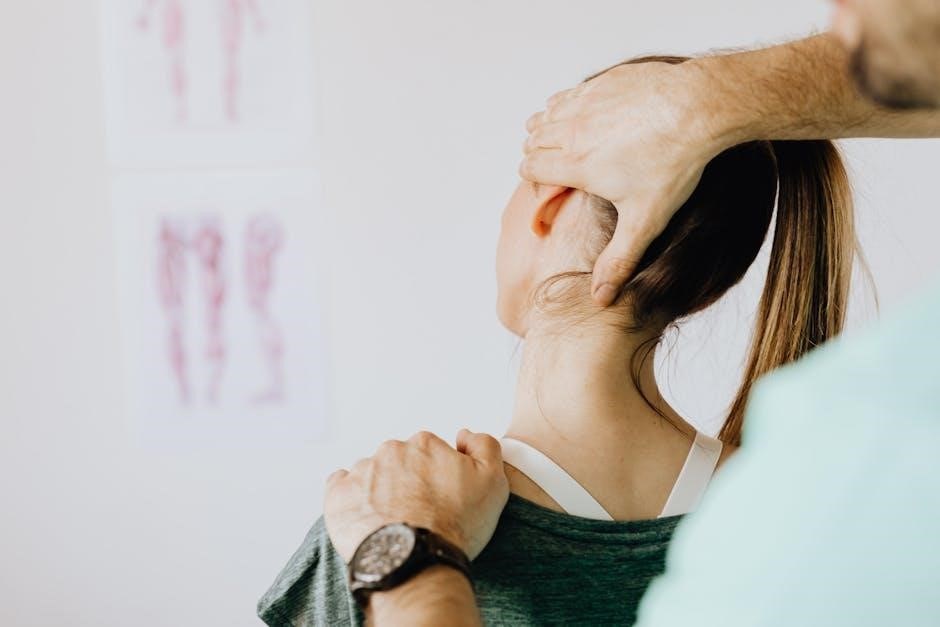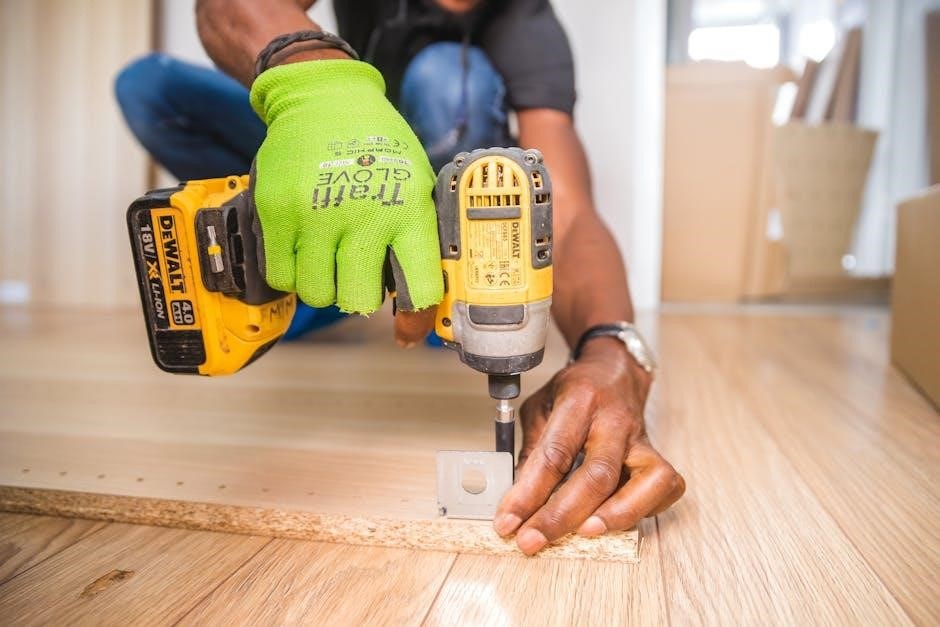This structured approach ensures a safe and gradual recovery, focusing on protecting the repair while restoring strength, mobility, and function. The evidence-based protocol guides patients through phased rehabilitation, emphasizing proper healing and return to activity.
Overview of Meniscus Repair and Rehabilitation Goals
The primary goal of meniscus repair rehabilitation is to protect the repair, restore knee function, and safely progress toward pre-injury activity levels. The protocol emphasizes tissue healing, pain management, and gradual strengthening. Key objectives include achieving full range of motion, improving strength and proprioception, and minimizing complications. Rehabilitation is divided into phases, with specific milestones for each stage, ensuring a structured and evidence-based approach. Criteria-based progression guides advancements, allowing for individualized care based on the patient’s recovery and surgical details. Ultimately, the goal is to optimize functional outcomes and facilitate a successful return to daily activities or sports, ensuring long-term joint health and stability.
Importance of Adhering to the Rehabilitation Protocol
Adhering to the rehabilitation protocol is crucial for ensuring proper healing, minimizing complications, and achieving optimal outcomes after meniscus repair. Deviating from the structured plan may lead to prolonged recovery, re-injury, or suboptimal results. The protocol is designed to balance tissue healing with gradual functional progression, reducing the risk of further damage. Compliance ensures the meniscus repair is protected during the critical healing phases, allowing for the restoration of strength, mobility, and stability. Consistency in following the guidelines also helps patients regain pre-injury activity levels safely and efficiently. Proper adherence minimizes the likelihood of chronic pain or limited function, ensuring a successful and sustainable recovery.

Phase 1: Immediate Post-Surgery (0-2 Weeks)
Focus on immobilization, pain management, and swelling reduction. Use a ROM brace, avoid weight-bearing, and prioritize rest, ice, and elevation to promote healing and stability.
Weight Bearing Status and Immobilization
Post-surgery, patients are typically non-weight-bearing for the first 2 weeks to protect the meniscus repair. A ROM brace is used to immobilize the knee, limiting flexion and extension. The brace is worn continuously, except for sleeping, and set to 0° to 90° to avoid stress on the repair. Weight-bearing status varies depending on the repair’s location and surgeon preference, but most protocols start with partial weight-bearing and progress gradually. Immobilization is critical to allow initial healing and prevent disruption of the repair. Patients are advised to avoid tibial rotation for 8 weeks to further protect the meniscus during the early healing phase.
Range of Motion (ROM) Restrictions and Early Exercises
Early ROM is restricted to 0° to 90° of flexion to protect the repair. Patients perform passive ROM exercises, such as heel slides and straight leg raises, twice daily to maintain joint mobility. Gentle exercises, like straight leg raises without resistance, strengthen the quadriceps and hamstrings without stressing the repair. Progression beyond 60° is allowed after 3 weeks, as tolerated. Early exercises focus on promoting healing while avoiding excessive stress on the meniscus. These activities are crucial for restoring functional movement and preventing stiffness, ensuring a foundation for advanced rehabilitation phases. Supervised progression ensures safety and adherence to healing timelines.
Pain Management and Swelling Reduction Techniques
Cryotherapy is applied continuously for the first 72 hours post-surgery, then as needed, to reduce swelling and pain. Compression wraps and elevation of the affected limb further aid in minimizing edema. Pain management typically involves prescribed medications or over-the-counter anti-inflammatory drugs, tailored to the patient’s discomfort level. Gentle mobilization and early exercises are balanced to avoid exacerbating pain while promoting recovery. These techniques are critical in the initial healing phase, ensuring patient comfort and optimizing the repair environment. Clinical judgement guides adjustments to these strategies based on individual progression and symptoms.

Phase 2: Early Rehabilitation (2-6 Weeks)
Phase 2 focuses on advancing range of motion and introducing strengthening exercises. Weight-bearing activities and gait training are gradually incorporated, with individualized progression based on clinical assessment;
Progression of ROM and Strengthening Exercises
During Phase 2, the focus is on advancing range of motion (ROM) beyond initial post-surgical limitations. Patients progress to controlled exercises like straight leg raises, mini squats, and hamstring stretches. Strengthening exercises target the quadriceps, hamstrings, and calf muscles to improve knee stability. A brace may still be used for support, but ROM is gradually increased to promote functional movement. Clinical assessments guide the intensity and progression of exercises. The goal is to restore muscle balance and prepare the knee for weight-bearing activities. Exercises are performed 2-3 times daily, with a focus on proper form to avoid re-injury. Cryotherapy may continue to manage swelling and pain.
Weight-bearing and gait training are introduced in Phase 2 to restore normal walking patterns and improve knee function. Patients begin with partial weight-bearing using crutches, progressing to full weight-bearing as tolerated. A knee brace may be used for support during this phase. Gait training focuses on achieving a normal heel-to-toe walking pattern without compensation. Strengthening exercises and balance activities complement weight-bearing progress to enhance knee stability. The goal is to minimize limp and ensure proper load distribution across the knee joint. Clinical assessments and patient tolerance guide the progression of weight-bearing activities, ensuring a safe transition to more dynamic movements.
Continuation of Pain and Swelling Management
Pain and swelling management remains critical during Phase 2 to ensure patient comfort and promote healing. Cryotherapy is recommended for the first 6 weeks, applied intermittently to reduce inflammation. Elevation of the affected limb above heart level for 20-30 minutes, several times daily, helps minimize swelling. Compression sleeves or elastic bandages can also be used to support the knee and reduce edema. Pain relief medications, such as NSAIDs, may be prescribed to manage discomfort. Monitoring for signs of complications, like prolonged swelling or increased pain, is essential. Patient adherence to these strategies ensures optimal recovery and prepares the knee for advanced rehabilitation exercises.

Phase 3: Advanced Rehabilitation (6-12 Weeks)
Focuses on advancing strength, proprioception, and functional activities. Includes high-level exercises, balance training, and gradual return to weight-bearing and sport-specific movements to restore pre-injury function.
High-Level Strengthening and Proprioception Exercises
Phase 3 emphasizes advanced strengthening, focusing on single-leg exercises, balance drills, and plyometrics to enhance lower limb stability and power. Proprioceptive training includes wobble board and BOSU ball exercises to improve joint awareness and neuromuscular control. Functional drills, such as lateral shuffles and step-ups, mimic real-world movements, preparing the knee for dynamic activities. Strengthening exercises target the quadriceps, hamstrings, and calves to restore pre-injury strength levels. These activities are progressively intensified to ensure the knee can handle increased stress without compromising the repair. The goal is to achieve symmetrical strength and stability compared to the uninjured limb, reducing the risk of re-injury during return to activity.
Agility and Balance Training
Agility and balance training in Phase 3 focuses on restoring dynamic stability and functional movement patterns. Patients progress to lateral shuffles, figure-eight drills, and cone exercises to enhance speed and directional changes. Balance exercises on unstable surfaces, such as BOSU balls or wobble boards, improve proprioception and knee stability. These drills simulate sports-specific movements, preparing the knee for dynamic activities. Progression includes adding resistance bands or plyometric elements to increase difficulty. The goal is to achieve seamless transitions between movements while maintaining proper knee mechanics, reducing the risk of re-injury and improving overall athletic performance. This phase bridges the gap between rehabilitation and return to sport.
Preparation for Return to Functional Activities
This phase emphasizes simulating real-life and sports-specific tasks to ensure readiness for full activity. Patients engage in functional exercises like stair climbing, pivoting, and controlled bounding. Strengthening focuses on power and endurance with resistance bands and plyometric drills. Mobility and flexibility are maintained through dynamic stretching. Psychological readiness is addressed to build confidence in performing daily or athletic activities without fear of re-injury. A gradual return-to-task plan is tailored, ensuring the knee can handle repetitive stress and dynamic movements safely. The endpoint is achieving pre-injury function, enabling a smooth transition back to work, sports, or daily activities without compromise in performance or safety.

Phase 4: Return to Sport or Full Activity (3-6 Months)
This phase focuses on high-level functional tests, advanced assessments, and final conditioning to ensure readiness for sport or full activity, with progression to dynamic, high-demand tasks safely.
Criteria for Safe Return to Sport
The decision to return to sport is based on achieving specific functional milestones. Patients must demonstrate at least 90% strength and proprioception compared to the uninjured limb. Functional assessments, such as hop tests and agility drills, must show symmetry and competence. Pain and swelling should be absent during high-level activities. Psychological readiness and confidence in the knee are also critical. A gradual progression to sport-specific drills ensures a safe transition. Final clearance is granted when these criteria are met, typically between 3-6 months post-surgery, depending on the individual’s progress and the nature of the repair.
Advanced Functional Tests and Assessments
Advanced functional tests evaluate readiness for high-level activities and sports. These include hop tests (e.g., single-leg hop for distance and crossover hop), agility drills, and strength assessments. Patients must demonstrate symmetric performance compared to the uninjured limb. Proprioception and balance are tested using single-leg stands and dynamic stability exercises. Functional movement screens assess proper mechanics during activities like squats and lunges. These evaluations ensure the knee can withstand sport-specific demands without risking re-injury. Progression to advanced drills is permitted only when these tests confirm adequate strength, stability, and functional competence, aligning with criteria-based milestones in the rehabilitation protocol.
Final Strengthening and Conditioning Drills
Final strengthening and conditioning drills focus on restoring peak strength, power, and endurance. These advanced exercises include plyometric training, agility ladder drills, and sport-specific movements. Emphasis is placed on explosive power, quick changes of direction, and functional movements that mimic the patient’s specific sport or activity; Proper form and technique are critical to avoid re-injury. Drills are progressively intensified based on the patient’s tolerance and performance. The goal is to ensure the patient can safely return to their pre-injury activity level with optimal strength and confidence.

General Rehabilitation Guidelines
General rehabilitation guidelines emphasize the use of braces and cryotherapy to enhance healing and comfort. Adherence to the structured program is crucial for optimal recovery.

Use of Braces and Cryotherapy
Braces and cryotherapy are essential components of the rehabilitation process. A ROM brace is typically worn for the first 3 weeks to protect the knee and limit excessive movement. It should be removed during exercises and sleep after the first week. Cryotherapy, such as icing, is recommended for the first 72 hours post-surgery and as needed thereafter to reduce swelling and pain. These tools support the healing process and enhance patient comfort during the early stages of recovery. Consistent use of braces and cryotherapy helps maintain knee stability and promotes a smooth transition into more active phases of rehabilitation.
Exercises to Avoid During Early Rehabilitation
During the initial stages of recovery, certain exercises should be avoided to protect the meniscus repair. Deep squats, pivoting, and high-impact activities are contraindicated to prevent stress on the repair site. Avoid forced knee flexion beyond 90 degrees for the first 4 weeks and any closed-chain exercises (e.g., lunges) that may compromise the repair. Activities involving tibial rotation should be avoided for 8 weeks to minimize risk of re-injury. Patients should also avoid weight-bearing exercises that cause pain or discomfort, as this may indicate excessive stress on the healing tissue. Consulting with a healthcare provider or physical therapist is crucial to ensure safe progression through the rehabilitation program.
Importance of Compliance with Rehabilitation Program
Adhering to the rehabilitation program is crucial for optimal recovery after meniscus repair. Compliance ensures proper healing, minimizes re-injury risk, and restores functional abilities. Deviating from the protocol can delay recovery or lead to prolonged rehabilitation. Patients must follow prescribed exercises, weight-bearing guidelines, and activity restrictions to achieve the best outcomes. Consistent communication with healthcare providers and physical therapists is essential to address concerns and adjust the program as needed. Full commitment to the plan helps patients safely progress toward their goals, whether returning to daily activities or sports, ensuring long-term joint health and functionality. Compliance is key to a successful and sustainable recovery.

Common Complications and Considerations
Potential complications include re-injury, prolonged recovery, or incomplete healing. Considerations involve individual factors like tissue healing, concomitant injuries, and patient compliance, requiring tailored monitoring to ensure proper recovery.
Risk Factors for Re-Injury or Prolonged Recovery
Non-compliance with rehabilitation protocols, concomitant injuries, and biological healing limitations are key risk factors. Poor adherence to weight-bearing restrictions or overloading the knee prematurely can lead to re-injury. Additionally, pre-existing degenerative changes, inadequate nutrition, or smoking may impede healing. Structural factors, such as the size and location of the meniscus repair, also influence recovery outcomes. Patients with higher activity levels or those returning to sports are at increased risk of re-injury if proper progression criteria are not met. Early identification and management of these factors are critical to minimizing complications and ensuring a successful recovery.
Management of Post-Surgical Complications
Post-surgical complications, such as infection, stiffness, or re-tears, require prompt intervention. Infections are managed with antibiotics or surgical irrigation. Arthrofibrosis is addressed with aggressive physical therapy and occasional arthroscopic lysis of adhesions. Recurrent tears or repair failures may necessitate revision surgery. Nerve-related complications, such as numbness or weakness, are evaluated with electromyography and treated conservatively or surgically. Blood clots are managed with anticoagulation therapy. Clinicians must monitor for these issues and adjust the rehabilitation protocol accordingly to ensure optimal recovery. Early detection and treatment are critical to preventing long-term functional limitations and ensuring successful outcomes.
Adjustments for Concomitant Injuries or Procedures
In cases of concomitant injuries, such as ACL tears or ligament repairs, the rehabilitation protocol must be tailored to address all pathologies. For example, ACL reconstruction alongside meniscus repair may require prolonged protection of the graft, delaying certain exercises. Additional injuries, like chondral defects, may necessitate modified weight-bearing statuses or restricted range of motion to avoid further cartilage damage. Strengthening exercises may be intensified to compensate for ligamentous instability. The protocol must balance the needs of all injured structures, ensuring no single injury is overdressed at the expense of others. Clinical judgment and patient-specific factors guide these adjustments to optimize recovery outcomes.

Additional Resources and References
Downloadable PDF guides and peer-reviewed articles provide detailed rehabilitation protocols, clinical guidelines, and evidence-based practices for meniscus repair, including return-to-sport criteria and functional assessments.
Recommended PDF Guides and Clinical Protocols
Downloadable PDF guides, such as those from Massachusetts General Brigham and UVA Sports Medicine, offer comprehensive rehabilitation protocols for meniscus repair. These resources include detailed phase-based progression, exercises, and return-to-sport criteria. Clinical protocols outline evidence-based practices, ensuring safe and effective recovery. They often feature timelines, weight-bearing guidelines, and functional assessments. These guides are invaluable for clinicians and patients, providing structured approaches to rehabilitation. Many PDFs also include illustrations of exercises and braces, enhancing understanding and compliance. Referencing peer-reviewed articles and institutional protocols ensures the information is reliable and up-to-date, aiding in optimal outcomes for meniscus repair recovery.

References to Peer-Reviewed Articles and Studies
Peer-reviewed articles and studies provide evidence-based foundations for meniscus repair rehabilitation protocols. Journals like the Journal of Orthopaedic & Sports Physical Therapy and British Journal of Sports Medicine publish research on optimal recovery strategies. Studies from institutions such as Massachusetts General Brigham and UVA Sports Medicine detail phase-based rehabilitation, emphasizing criteria-based progression. These references highlight the importance of protecting the repair while restoring function. They also explore outcomes of various surgical techniques and rehabilitation approaches, offering insights for clinicians and patients. These studies are essential for developing and refining effective, evidence-based rehabilitation protocols, ensuring safe and successful recovery from meniscus repair surgery.
